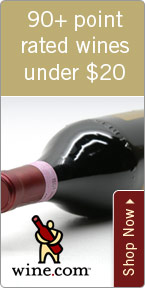Wines Without The Chemicals

Wednesday - January 13, 2006
| Share
 Del.icio.us
Del.icio.usI’ve made my New Year’s resolutions, and one of them is to live healthier. With health in mind, and with more people asking for “healthy” wines every year, I want to elaborate on the subject of “organic” and bio-dynamically produced wines. There has been wave of demand for organically farmed produce around the world, and this demand is finally reaching the wine industry.
Legally speaking, the U.S. Department of Agriculture (USDA) defines “organic wines” as “a wine made from organically grown grapes and without any added sulfites.” Growing grapes organically involves methods of production that do not employ any synthetic chemical products - no man-made pesticides, fungicides or fertilizers.
Of course, natural fertilizers such as manure or compost are allowed, and even encouraged. Remedies used to combat pests or insects include natural predation - ladybugs that prey upon aphids that feed on vine leafs, for instance. In contrast, conventionally farmed vineyards use chemicals sprays for almost everything. Many of these sprays include trace elements that become malevolent residue in the vineyard. After many years it’s easy to see that a buildup of any foreign chemical can lead to a most debilitating effect on the health of the vineyard. With organic farming there are no chemicals, therefore leading to a more vibrant and healthier vineyard. This in turn is supposed to translate into a better wine.
And some chemicals sprayed on grapes can show up in the wine as residue, thus ending up in our bodies when we drink them.
The second half of the definition of “organic wines” is “without any added sulfites.” This is a difficult sticking point in the production of high quality wines. Grapes and grape juice are highly prone to oxidation. This is the process that turns the color of white grape juice brown once it is exposed to oxygen. Can you imagine drinking a bottle of Chardonnay that looked more like a cola? In order to avoid this dis-coloring, winemakers add sulfur dioxide as a preservative. Most conscientious winemakers will use only what is needed; but others use too much. The USDA allows wine to have up to 100 parts per million and still be considered “organic.” Despite winemakers’ best efforts, however, most wines still result in having more than 100ppm of sulfur dioxide in their wines. This is why there are very few wines that can say that they are truly “organic.” Instead the USDA allows them to use the term “wines made from organically grown grapes.” on labels.
Bio-dynamically produced wines takes the organic approach to another cosmic level. The school of bio-dynamic viticulture centers on the philosophies and teachings of the Austrian scientist/philosopher Rudolf Steiner. He incorporated cosmic rhythms into his practices as well as special preparations to be sprayed in vineyards - one of which includes cow manure fermented in a cow horn, which is then buried in the soil, then sprayed on the soil during a certain lunar period. These practices have shown to improve the health of the vineyard significantly as well as a marked improvement in the quality of the wine.
The list of producers that have implemented either organic or bio-dynamic practices is an impressive one. It includes such luminaries such as Domaine de la Romanee Conti, Domaine Leroy, Zind Humbrecht, Weinbach, Ostertag, Chapoutier, Barral, Gravner and Au Bon Climat. There are many more, and the number grows every year.
All these methods are supposed to ameliorate the health of the vineyard as well as extend its life, and result in better wine. So do they? Without question, the vineyards are benefiting from these practices. But I’ve had good wines and bad wines that were organically or bio-dynamically produced. What I do appreciate about these wines, especially bio-dynamics, are that they seem to be more expressive of the place from which they come. At their best, they have more character and complexity. In my mind, they hit higher heights than the great majority of conventionally produced wines, because they relate a story of place and individuality. Here are a couple of recommendations:
2003 Zind Humbrecht Riesling ($23) Bio-dynamic
This is the first ever blended Riesling from Zind Humbrecht, which includes such great vineyard sites as Herrenweg, Clos Windsbuhl and Rotenberg.
Tropical fruit laced with a brilliant mineral edge and an unbelievably elegant finish. Absolutely delicious! Curry anyone?
2003 A&P De Villaine Bourgogne Rouge “La Digoine” ($35) Bio-dynamic
This Pinot Noir from the family estate of Aubert de Villaine (yes, the part owner of DRC) absolutely hums with overripe red berry fruit flavor and richness that puts many California counterparts to shame. Have it with duck and you’ll be smiling.
Roberto Viernes is a master sommelier. E-mail .(JavaScript must be enabled to view this email address)E-mail this story | Print this page | Comments (0) | Archive | RSS Comments (0) |
Most Recent Comment(s):












